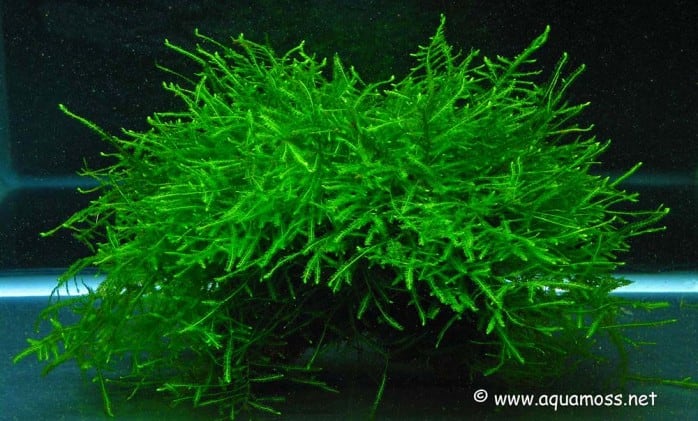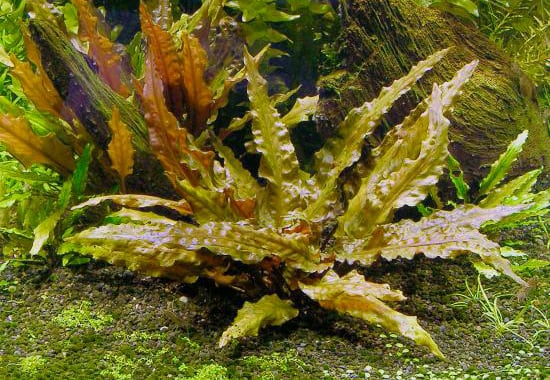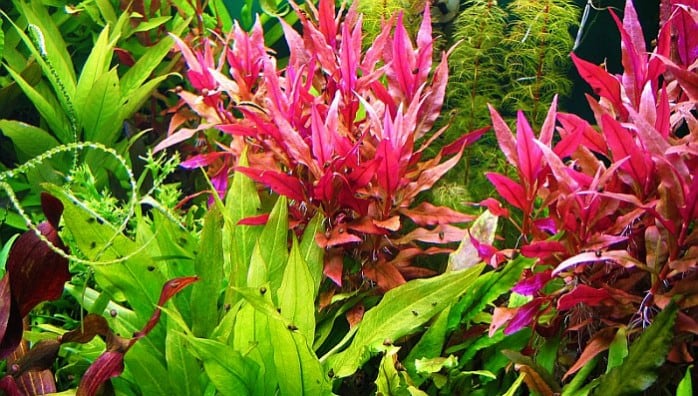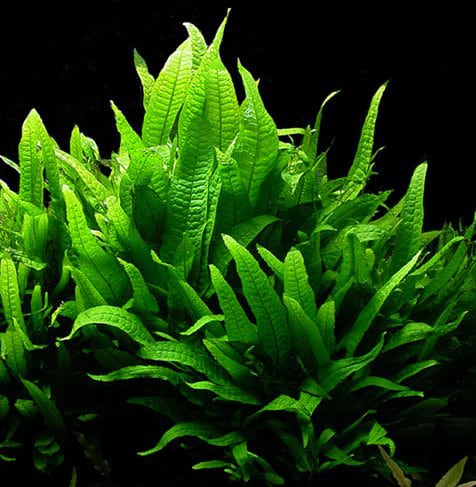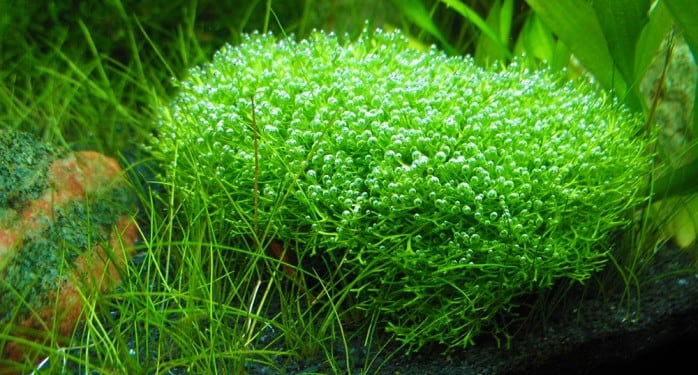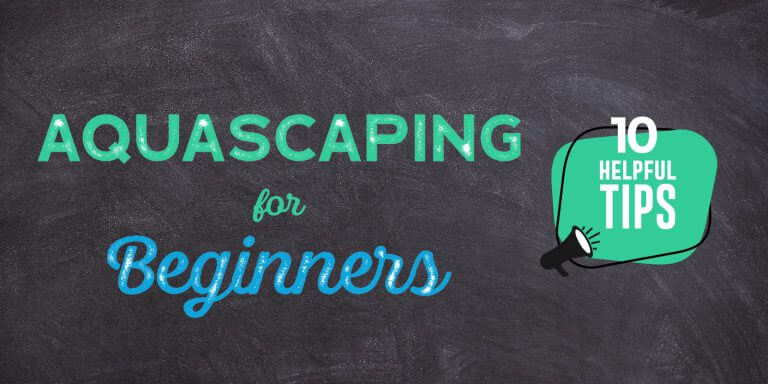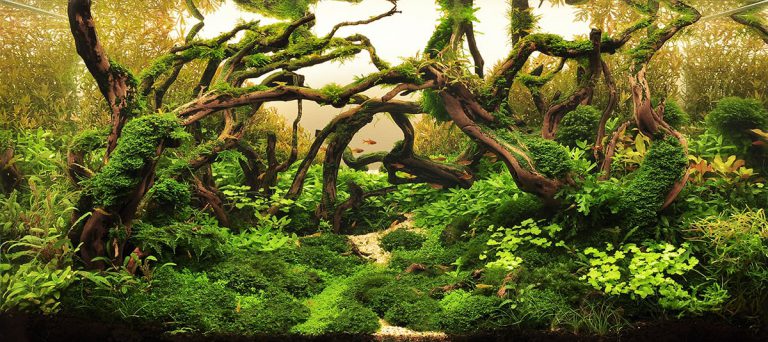As any good aquarist knows, aquarium plants are essential to a beautiful and successful aquascape. On that point there is no precise delimitation regarding the choice of the plants, as you are limited merely by your own creativity and vision; but look at a few aquascapes and you will find out that some species of aquarium plants are a usual happening in most of them, be it Nature Aquarium or Dutch style.
Java Moss – Taxiphyllum barbieri
Java Moss is the most common of the mosses used in aquariums and a popular choice for any aquarist, beginner and advanced alike. It is easy to grow and it can tolerate a wide range of water conditions.
Taxiphyllum barberi is one of the most very versatile aquarium plants. It is most commonly used attached to rocks and trees, giving them an aged and very natural appearance, or to use them with mesh and create beautiful walls to lay on the substrate or against the sides of the aquarium.
A good technique would be to use walls of Java Moss to cover equipment that would be otherwise visually obtrusive if left in view.
Java Moss grows fast and looks healthy in a water with a temperature around 24 degrees Celsius and bright lighting. As it grows it will spread in both a horizontal and vertical fashion, forming dense clusters.
Addition of CO² and fertilization (for a beautiful green use iron-based fertilizers) will increase the growth rate, but it can also grow without them. It can be invasive if left alone, so be sure to trim it from time to time.
Cryptocoryne wendtii ‘Red’
Cryptocoryne wendtii “Red” is a very adaptable aquarium plant which originates from Sri Lanka, with red-brownish leaves, that can be used in any area of the aquarium, emerged and submerged, if lighting and fertilization permits (preferably an iron-rich fertilizer).
This wonderful plant responds to light, so its growth depends heavily on light intensity. In aquariums with moderate light, it grows considerably taller, often reaching heights of 30-45 cm.
In aquariums with strong lighting, this species grows flattened, making it a good plant for the front of the aquarium or the middle-background. For best results, use Cryptocoryne as a solitary plant.
They may also be planted in groups with good results, with the smaller types in the foreground of the aquarium and the larger ones in the center and back.
Be careful when using this Cryptocoryne in aquascaping as changes in their environment makes the leaves of the aquatic plant turn into mush very rapidly, a condition known as the “Crypt melt”.
Magenta Water Hedge – Alternanthera reineckii ‘roseafolia’
Worldwide there are 170 identified species of aquarium plants in the genus Alternanthera. Alternanthera reineckii originates from the Amazon in South America and out of the 5 varieties of this aquarium plant, Alternanthera reineckii ”roseafolia” is the easiest species of this genus to grow and maintain, perfect for a beginner aquascaper.
Although Alternanthera reineckii ‘roseafolia’ can be grown in the majority of conditions, it will only reach full potential and develop its beautiful red-purplish leaves only when provided plenty of light, a soft slightly acidic water and a decent source of CO².
The purple colour provides an effective contrast to the many green aquarium plants in your aquascape, especially when planted in groups, by placing several of them in the background. It is recommended to clip the plant regularly, in order to encourage the plant to sprout more side shoots and to become more bushy.
Alternanthera reineckii ‘roseafolia’ is a very popular aqurium plant commonly found in the Dutch and Jungle style aquariums, but not much so in the Nature Aquarium style.
Java Fern – Microsorum pteropus
The Java Fern is an amphibious aquarium plant from Southeast Asia, which is found growing in the wild, along rapid currents; it grows equally happy submerged and emerged.
Java Fern has very mild demands, and can thrive and look beautiful under virtually any light or in any water conditions. It does need, however, an iron-based fertilizer otherwise the rich green color will fade becoming olivy and ugly, and eventually the leaves will turn black.
The ferns can be planted either individually or in small groups, preferably near a stream of water. They look very good when planted in the middle in combination with other aquatic plants and decor, as they will not grow tall enough to block the view of the plants behind them.
The fern will not root if planted directly into gravel or other substrate; best you use it attached on a piece of driftwood or a rock to give your aquarium a more natural and realistic look.
Crystalwort – Riccia Fluitans
Riccia fluitans is a versatile aquarium plant and usually doesn’t require intensive care. In general, this plant can be found almost everywhere in the world, in the wild – Japan, Europe, Thailand and Singapore, but only the Japanese version is suitable for submerged growth.
When allowed to float, Riccia fluitans will grow rapidly in an amorphous, roughly spherical and slightly flattened form. However, the most popular way of using this plant is to attach it to rocks and wood, usually with a thin wire.
After a surprisingly short period of time (only about two weeks), the thread will be completely covered by the plant. It also can be used as a carpet plant in the front of the tank if it is held down with small stones or threads. The resulting effect will be that of a well-groomed lawn or a moss covered rock.
Enjoyed this article? Spread the word by sharing it with your friends!


